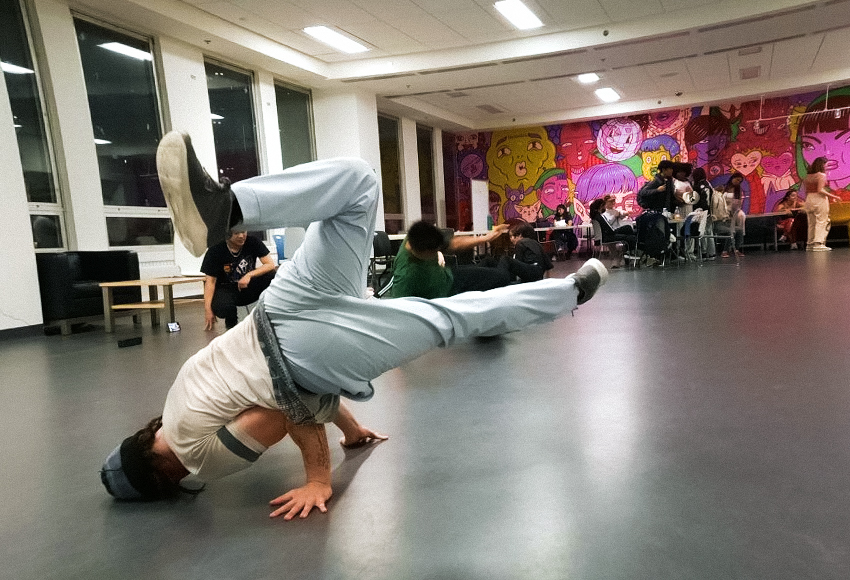New faces appeared on the Hall Building’s walls last spring
A project initiated by the CSU financed two murals that were painted in May. Artists Monosourcil and Teenadult were invited to embellish the downtown campus. Colourful and detailed, the artworks’ aim is to represent all aspects of campus life. The student group who initiated the project were finalists for the Forces AVENIR provincial awards in the Arts, Letters, and Culture category.
The seventh floor of the Hall Building is always full of life. During the day, students chat and study while others wait in line for a meal at The People’s Potato. In the evening, a completely different crowd, and groups of dancers gather, in the open space.
Cristobal Perez-Boudon comes to campus almost every day after work to practice breakdancing. “People come to dance here all the time. Sometimes we are more than 30 people. There are the K-pop dancers and the B-boys,” he explained.
Perez-Boudon witnessed the production of the murals, and for him, they added new energy to the space. “Since they are here, it feels like having our own studio. Before it was just an empty white space, you could think it was a cafeteria, but now there is something more.”
Plain, white walls are what stayed in Christopher Vaccarella’s mind when he started studying at Concordia in 2017. “Everything was the same colour, no life, no personality,” he said. When he became a councilor for the CSU, adding art to the campus walls was one of the projects he wanted to propose.
Former CSU coordinators, Shivaane S. and Camina Harrison-Chéry both joined forces with Vaccarella to secure the funding needed to produce the murals.
Their goal was to feature female and BIPOC artists. “We all wanted the same thing where it focuses on diversity and people you don’t often see at festivals,” said Vaccarella.
Art on campus
Painted beside the CSU office, Maxilie Martel-Racicot’s mural reflects the artist’s unique style while integrating elements from Concordia’s faculties. Depicted in contrasting shades of colour, the detailed work presents a large group of characters. Their identities are unclear, neither human nor animal.
Under her artist’s name, Monosourcil, Martel-Racicot created a world of her own in which she mixes sci-fi inspirations with references to everyday life. For the muralist, the themes of coexistence, tolerance, and multiculturalism are always central to her work. “We are all humans, social animals, so it’s this idea that I represent, that we live in a group and in a community in a certain way,” she said.
On the CSU’s Art Nook walls, artist Kezna Dalz (who also goes by Teenadult) replaced the seventh floor’s light grey walls with a creation full of flowers and butterflies. Dalz included the words “art heals” in her work. In the center are two black faces, as the artist aims to include diversity in all her creations.
With this specific one, Dalz also wanted to create a positive atmosphere in the space. “The faces are tilted upwards, so it’s about being confident, and just feeling good and creating in a space where you are feeling yourself,” she explained.
“People gravitate towards colour,” said former CSU coordinator Shivaane S.. She sees this addition to the Art Nook as a way to make the space even more inspiring for students, and to “cultivate more student-life as well.”
For more public art
This is the first public art initiative to be fully student-led at Concordia. As the University is currently developing a new public art policy, the colourful murals engage a reflection on what art can add to life on campus. The new policy should be delivered this fall and then implemented in winter 2023.
Even though the project’s organizers have now left the CSU, the initiative is to be continued. A new mural should embellish the ceiling of Loyola’s G-Lounge this winter.
Loyola’s new CSU coordinator, Sabrina Morena, believes art is meaningful to campus life: “To me, it means that we are not just here to study, we are also here to create a culture of care, and community.” She hopes to have even more murals painted at Concordia this year.
